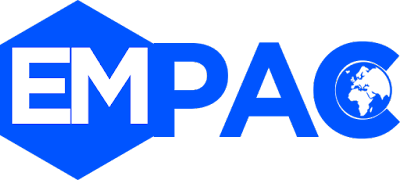CLICK HERE AND APPLY FOR ADMISSION
In the 21st century, information technology (IT) has morphed into a powerhouse of potential, fueling innovations across various industries and domains. For aspiring IT professionals, the challenge is to tap into this potential and propel their careers forward. That's where EMPAC-Emperors Academy, an elite NVTI I.T training school in Ghana, comes into play.
The
academy’s Introduction to Application Skills course stands as a beacon
for students aiming to acquire top-tier IT skills. These skills are not just
limited to traditional applications; the course also delves deep into the realm
of modern artificial intelligence. By mastering this content, students can give
a significant boost to their computing careers.
Why Choose EMPAC?
EMPAC,
short for Empac-Emperors Academy, is not just any IT training school. It is a
melting pot of knowledge, skills, and practical application. Located in the
heart of Ghana, EMPAC aims to bridge the gap between traditional education and
the ever-evolving world of IT. With state-of-the-art infrastructure,
experienced faculty, and a curriculum that is both comprehensive and
contemporary, EMPAC promises a learning experience like no other.
Course Curriculum
Overview: Introduction to Application Skills
The course
is meticulously designed to equip students with all the necessary application
skills. Here’s a sneak peek into the curriculum:
Module 1: Understanding
Application Software
- Introduction to application software
- Definition and categories of applications
- Differences between system software and
application software
- Types of application software
- Benefits of using application software
- Case Study: How applications transformed business
processes
Module 2: Word
Processing with Microsoft Word
- Introduction to MS Word
- User interface and ribbon
- Creating, opening, and saving documents
- Basic Document Formatting
- Text formatting: font, size, color, styles
- Paragraph formatting: alignment, spacing,
bullets, and numbering
- Advanced Formatting
- Headers, footers, and page numbering
- Styles, themes, and templates
- Columns and section breaks
- Text boxes and graphical elements
- Graphic Design in Word
- Inserting images, shapes, and SmartArt
- Image adjustments: cropping, effects, and styles
- Designing flyers and brochures
Module 3: Spreadsheets
with Microsoft Excel
- Introduction to MS Excel
- Workbook, worksheet, rows, columns, and cells
- The ribbon and formula bar
- Basic data entry and cell referencing
- Basic Formulas and Functions
- Arithmetic operations
- Sum, average, min, max, count
- Data Visualization
- Creating charts: bar, pie, line, scatter, etc.
- Formatting charts
- Advanced Excel Functions
- Lookup functions: VLOOKUP and HLOOKUP
- Logical functions: IF, AND, OR
- Date and time functions
- Data Analysis
- Pivot tables and pivot charts
- Conditional formatting and data bars
- Data validation and drop-down lists
Module 4: Presentations
with Microsoft PowerPoint
- Introduction to MS PowerPoint
- Slides, layouts, and themes
- Basic text and content addition
- Graphic Design in PowerPoint
- Incorporating multimedia: images, audio, video
- Designing infographics with shapes and SmartArt
- Custom animations and transitions
- Advanced PowerPoint Features
- Linking and embedding objects
- Master slides and slide design
- Interactive elements: action buttons, hyperlinks
Module 5: Databases with
Microsoft Access
- Introduction to MS Access
- Database, tables, queries, forms, and reports
- Primary keys and relationships
- Data types and field properties
- Basic Database Operations
- Creating tables and entering data
- Simple queries: select, sort, and criteria
- Designing basic forms and reports
- Advanced Database Management
- Relational database design
- Advanced queries: parameter, action, aggregate
- Macros and Visual Basic for Applications (VBA)
- Data import/export and database utilities
Module 6: Graphics and
Multimedia Skills
- Basics of graphic design applications
- Introduction to multimedia software
Module 7: Browsing and
Web Skills
- Introduction to web browsers
- Navigation, bookmarks, and history
- Privacy and security basics
- Basics of online collaboration tools
Module 8: Practical
Applications in Business Settings
- Managing a Printing Press
- Understanding different printing machinery and
their software interfaces
- Coordinating between design software and
printing machinery
- Quality assurance and color management in print
- Managing an Office
- Setting up productivity software suites for a
seamless workflow
- Using shared calendars, email clients, and task
management tools
- Integrating office equipment with application
software
- Managing an Internet Café
- Setting up user sessions and computer
reservation systems
- Maintenance of computer systems and ensuring
internet security
- Using monitoring software to track and manage
user activity
- Business System Set-Up
- Assessing business needs to select appropriate
software
- Integrating various software platforms for
optimal business performance
- Implementation of Point of Sale (POS) systems,
inventory management, and customer relationship management tools
Module 9: Networking
Skills
- Introduction to Networking
- Basics of computer networks: LAN, WAN, VPN
- Networking hardware: routers, switches, modems
- IP addressing and subnetting basics
- Configuring and Setting Up a Network
- Setting up a wired/wireless network
- Network security: firewalls, VPNs, and
encryption
- Configuring basic network services: DHCP, DNS
- Advanced Networking Concepts
- Network topology and design
- Virtual LANs and network segmentation
- Network troubleshooting and tools
Module 10:
Troubleshooting and Tips
- Common problems and solutions
- Best practices for using application software
- Staying updated with software changes
Module 11: Conclusion
and Exploration
- Recap of what's been learned
- Exploring other software and applications
- Future trends in application software
Conclusion:
The Introduction to Application
Skills course at EMPAC is not just a course; it's a doorway to
opportunities, innovations, and a promising future in the IT sector. By
enrolling in this program, students aren't just learning; they are preparing to
become the IT leaders of tomorrow.
So, if you're looking to transform
your passion for IT into a thriving career, the Introduction to Application
Skills course at EMPAC-Emperors Academy is the way forward. Enroll today and
embark on a journey of knowledge, innovation, and success.






0 Comments